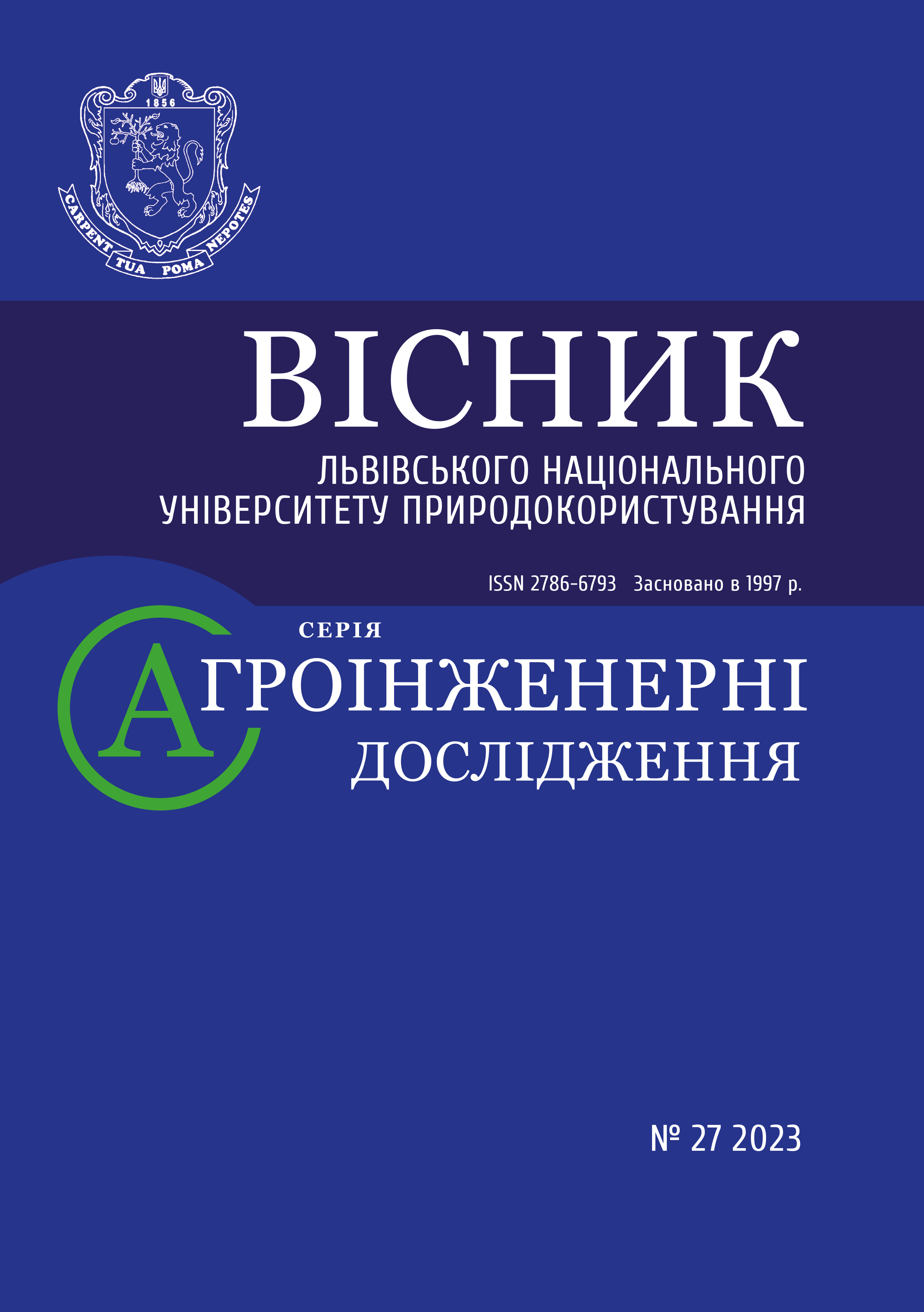Mathematical modeling of grain cooling in bunker systems with radial air distribution
DOI:
https://doi.org/10.31734/agroengineering2023.27.101Keywords:
grain, cooling, heat exchange, air, bunker, radial airflowAbstract
The need to create or improve the existing grain cooling systems after drying, which operate separately from grain dryers (portable grain coolers), is currently caused by the requirements to increase the efficiency of dryers on farms (by using cooling chambers as drying units) and the emergence of integrated grain dryers with solid fuel furnaces that operate with periodic loading. One way to address the challenges of creating portable grain coolers after drying is to utilize ventilated bunkers with radial distribution of external atmospheric air for grain cooling. To ensure their effective operation and to align the productivity of the cooler with that of the dryer, it is essential to study the patterns of heat exchange in non-steady-state conditions and determine optimal structural and operational parameters. Such research is best conducted by developing mathematical models of non-steady-state thermal processes during the cooling of heated and dried grain. The present work proposes a developed mathematical model of the grain cooling process in bunker systems with radial air distribution based on a two-level hierarchy: microkinetics and macrokinetics of grain cooling.
At the microkinetics level, the equation of non-steady-state heat conduction for a grain particle (or a grain layer element) with a negative heat source is employed, along with the boundary conditions for convective heat exchange. At the second level, the grain cooling model is represented by a differential equation for heat exchange of a ring-shaped grain element with radially moving cooling air. The solution to this equation is implemented in the Mathematica computer environment for two airflow scenarios: from the center of the bunker to the outer surface and in the opposite direction. The results of the calculations are graphically illustrated. It has been determined that the temperature non-uniformity of grain along the radial coordinate of the layer during the final stage of the process, with air filtration from the external cylinder to the central one, is 20-30 % lower than when air filtration is carried out in the reverse direction.
References
Haponiuk, O. I., Ostapchuk, H. M., Stankevych, I. I. & Haponiuk I.I. (2014). Active ventilation and drying of grain. Odesa: VMV.
Kalinichenko R. A. (2016). Algorithm of parametric identification of analytical mathematical description of dynamics of low-temperature drying of grain materials. Mechanization and electrification of agriculture, 3(102).
Kalinichenko, R. A. (2016). Determination of thermophysical coefficients in solutions of the equation of thermal conductivity for identification of heat treatment processes of grain materials. Scientific Bulletin of NUBiP of Ukraine. Series: Machinery and Power Engineering of Agro-Industrial Complex, 241, 325-333.
Kalinichenko, R. A., & Voityuk, V. D. (2017). Energy efficient modes of operation of machines for high-intensity heat treatment of grain materials. Nizhyn: Publishing Center of NDU named after Hogol.
Kiurchev, S. V. (2019). Mechanical and technological substantiation of post-harvest processing and storage of seeds of grains and oilseeds. (Extended abstract of Dis. ... Dr. Techn. Sciences). National. Acad. Agrarian. Sciences of Ukraine, National. Sciences. Center "Institute of Mechanization and Electrification". Glevaha.
Kiurchev, S. V., Kiurcheva, L. M., & Verkholantseva, V. O. (2018). Determination of an important factor of wheat quality in the process of storage using cooling. Proceedings of the Tavria State Agrotechnological University. Technical sciences, 18(1), 3-11.
Kotov, B. I. (2017). Modeling of technological processes in typical objects of post-harvest processing and storage of grain (cleaning, separation, drying, active ventilation, cooling): [Collection monograph]. National. Acad. Agrarian. Sciences of Ukraine, National. Sciences. Center "Institute of Mechanization and Electrification of Villages. household". Kyiv; Nizhyn: Lysenko M. M.
Kotov, B. I., & Hryshchenko, V. O. (2017). Mathematical model of cooling of wet grain in ventilated bins with radial air distribution. Design, production and operation of agricultural machines, 47(1), 132-139.
Kotov, B. I., Kalinichenko, R. A., & Kifiak, V. V. (2015). Modeling of dynamics of heating and cooling of grain products in the mode of pneumatic conveyor. Environmental engineering, 1, 40–43.
Kotov, B. I., Kalinichenko, R. A., & Kurgansky, O. D. (2017). Heat and mass transfer during drying and cooling of grain material in a dense moving layer. Machinery, energy, transport of agro-industrial complex, 1(96), 93–95.
Kotov, B. I., Spirin, A., Tverdokhlib, I., & Kalinichenko, R. (2018). Theoretical researches of cooling process regularity of the grain material in the layer. INMATEH-AGRICULTURAL ENGINEERING, 54, 87-94.
Kurhanskyi, O. D., & Kotov, B. I. (2016). Analysis of the methods for cooling grain material. Machinery, energy, transport of agro-industrial complex, 2(94), 49–52.
Palamarchuk, I., Kürchev, S., & Verkholantseva, V. (2018). Vibrowave semifluidization process of low-temperature processing of plant raw materials. Socio-economic development of the agrarian sphere: engineering and economic support: Proceedings of the International scientific and practical conference. (pp. 308-310). Ternopil: FOP Palyanytsya V. A.
Stankevych, H. N., Shapovalenko, O. I., Strakhova, T. V., Petrunya, B. M., Yakovenko, A. I., & Ostapchuk, M. V., (1997). Instructions for drying food, feed grain, oilseeds and operation of grain dryers. Odesa: ARD-LTD.
Verkholantseva, V. O. (2011). Determination of efficiency of application of a grain cooling method. Proceedings of Tavria State Agrotechnological University. Melitopol: TSATU, 11(1), 326-331.
Verkholantseva, V. O. (2016). Substantiation of regime parameters of cooling of grain raw materials during storage. (Diss. candidate techn. sciences). Vinnytsia.


